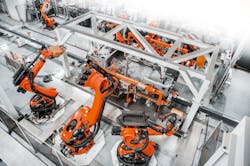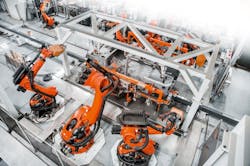IFR's top 5 robot trends
The International Federation of Robotics have named its top five trends shaping industries around the globe. According to the organization, annual installations of industrial robots more than tripled within from 2010-2019, reaching 381 thousand units in factories around the world.
(Source: The International Federation of Robotics)
"Advances in robot technologies are contributing to increased robot adoption,” says Dr. Susanne Bieller, general secretary of the IFR. "The COVID-19 pandemic hasn`t started any new trends but it accelerated the use of robotics beyond established practice. In this respect, the pandemic has proven to be the biggest single driver for change in industry." The biggest trends IFR found are as follows:
- Robots learn new tricks: Artificial intelligence software in combination with vision and other sensing systems, allow robots to master difficult tasks. One such task is bin picking, that in the past was only feasible for a human hand. New generations of robots are easier to install and program and they are connectable. Advances in communication protocols integrate robots into automation and Industry 4.0 strategies.
- Robots work in smart factories: The automotive industry have been using smart factory solutions utilizing industrial robots throughout assembly lines that have dominated traditional automobile production for more than 100 years. IFR says that the future belongs to networked interaction of robots and autonomous guided vehicles or autonomous mobile robots (AMRs). With the latest navigation technology, these mobile robots are more flexible compared to traditional production lines. Car bodies are conveyed on driverless transport systems. They can be decoupled from the assembly line flow and redirected to assembly stations where individually equipped variants can be assembled. When models are changed completely, reprogram the robots and AMRs rather than dismantle the entire production line. With the integration of human-robot collaboration workstations, robot suppliers report robots working hand-in-hand with humans without fencing.
- Robots enter new markets: Connectivity breakthroughs contribute to increased robot adoption in manufacturing sectors that have recently turned to automation. Ongoing digital transformation will lead to new business models. In the smart factory, different products are assembled subsequently by the same equipment, making the traditional production line a thing of the past.
- Robots reduce carbon footprint: Investments in modern robot technology will also be driven by the requirement for a smaller carbon footprint. Modern robots are energy-efficient and through higher precision, they produce fewer rejections and substandard goods. Robots help in the cost-efficient production of renewable energy equipment, such as photovoltaics or hydrogen fuel cells.
- Robots help to secure supply chains: Manufacturers have the opportunity to rethink supply with a completely different outlook because of the pandemic. IFR says when productivity is leveled through automation, manufacturers have increased flexibility that may not have been available in high-wage countries like most of the European Union, North America, Japan or the Republic of Korea. Robotic automation offers productivity, flexibility and security.


